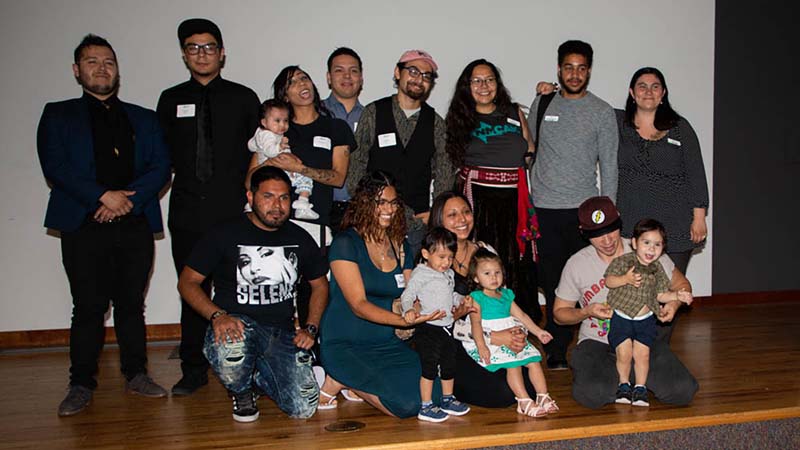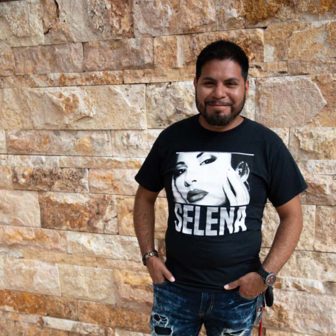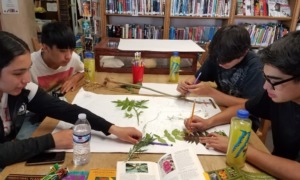
Photos by James Lawrence.
NMCAN’s Youth Leadership Team helped state legislators form foster care-related policy blueprints that were eventually signed into law during the 2019 New Mexico Legislature.
It has been a long haul for Melvin Lasiloo to get from where he started to attending community college classes in his hometown of Albuquerque, N.M. After landing in the foster care system at age 4, he ping-ponged from place to place all over New Mexico. In ninth grade, he started to find his footing but then was moved to a different foster home. He ended up repeating his freshman year three times.
“I’d always have to restart every class,” said Lasiloo, now 24. “Moving from foster home to foster home stopped me from finishing what I wanted to do.”
After aging out of foster care at 17, he started to make bad decisions, he says, and landed in prison for four years. When he got out, he desperately wanted to focus on his education but didn’t know how to go about it.
Eventually, a college adviser pointed Lasiloo toward NMCAN’s Back on Track program, which directs youth in foster care and young people coming out of the juvenile justice system to an educational pathway. Today Lasiloo, a member of the Zuni Tribe, is completing his first year at Central New Mexico Community College (CNM) in Albuquerque, where he’s studying to become a social worker.
The bridge program helps Albuquerque area youth ages 17 to 25 gain acceptance to and enroll in college or technical school. During their freshman year, it gives them the support needed to successfully tackle their school-life balance.
“The off-ramps from traditional education are very well lit for these populations. Once you’ve hit that off-ramp, it’s very hard to find an on-ramp,” said Ezra Spitzer, executive director of NMCAN, an Albuquerque-based nonprofit whose overall mission is to help youth transition to adulthood.
According to the New Mexico Children, Youth and Families Department’s National Youth in Transition database, only 45% of New Mexico’s foster youth hold a high school diploma or GED by the time they’ve aged out of foster care by their 19th birthdays. (Recent figures published by the National Conference of State Legislatures’ Child Welfare Project shows that 58% of foster kids nationally graduate high school, compared with 87% of all 19-year olds.) CYFD statistics also show that 46% of the state’s aged-out foster youth have experienced homelessness (versus 20% nationally) while 31% have been incarcerated at least once (NCSL’s Child Welfare Project says 30% of 21-year-old former foster youth reported criminal justice system involvement).
‘There’s no system here’
NMCAN’s Back on Track is a one-of-its-kind program in a state that an Annie E. Casey Foundation study ranks dead last nationally for overall child well-being. The coaching-based project, now in its third year, creates individualized education plans for youth through partnerships with CNM, The University of New Mexico and the Albuquerque-based Mission Graduate. Mission Graduate is a United Way initiative that seeks to add 60,000 new graduates with college degrees and certificates
to the central New Mexico workforce by 2020.
NMCAN also acts as a liaison with the New Mexico Department of Workforce Solutions and New Mexico Workforce Connection if employment is the top priority. CNM also offers a host of trade certificates, such as carpentry, automotive technology, electrical trades and plumbing.

A determined Melvin Lasiloo spent his entire childhood in foster care and a number of years in juvenile justice. He eventually discovered NMCAN’s Back on Track program and enrolled in community college, where he’s studying to become a social worker.
Spitzer and the NMCAN staff make sure a youth’s basic needs are met before launching into larger talks about school or career. That’s because New Mexico doesn’t have a hierarchy of support systems at the ready.
“Let’s get fed and then have the conversation about getting a diploma or GED or building financial literacy. You may have these immediate needs before we can have that big career conversations and support in enrolling,” Spitzer said. His organization also teaches workshops on emotional intelligence, healthy relationships, financial literacy and leadership development.
“I think what folks, especially from outside of New Mexico, struggle with is not understanding that there’s no system here. You’re basically creating this stuff from nothing,” Spitzer said. “It’s not like you say, ‘Oh yeah, we just need to get them into this system.’ No, there’s actually no system.”
NMCAN’s Back on Track has been a pillar for youths such as Joanna Delaney, who landed in the foster care system when she was 17. She had no idea where to begin the college admissions process until finding NMCAN, which helped her prepare financial aid paperwork to start classes at CNM.
“I thought college was for smart people because growing up, my family kind of made me feel really stupid,” Delaney said. “Once I got my GED, I had no idea how to make the college stuff work. I didn’t know who to talk to. I didn’t know what classes I would need. I didn’t know where to go in order to find the people I needed to talk to. I needed the help because it was too hard to do it by myself. I didn’t even know where the colleges were.”
New foster care legislation
During the 2019 state legislative session, which concluded March 16, lawmakers pushed through a number of foster care-related measures. Spitzer says the NMCAN Youth Leadership Team, comprised of youth who have matriculated through NMCAN’s programming and the organization’s leadership training, were instrumental in creating the policy blueprints.

NMCAN Executive Director Ezra Spitzer has led the Albuquerque based nonprofit, which helps youth make the move to adulthood, since 2012.
The new state laws include the extension of foster care services from age 18 to 21, additional funding for financial literacy training and a statute that requires institutions to give foster youth partial credits if they bounce from school to school. Spitzer says the partial-credit law is monumental for foster youth moving forward, and can prevent the scenarios that Lasiloo faced when he was forced to repeat the ninth grade due to the constant instability in his life.
Additionally, state lawmakers expanded eligibility for the state’s game-changing tuition and fee waiver, a 2014 law that allows foster youth to attend publicly funded post-secondary educational institutions for free. State Sen. George K. Munoz, a Democrat, sponsored the original piece of legislation as well as the expanded law that will encompass any child who was in state or tribal foster care on or after their 14th birthday.
“I’m just a legislator,” Munoz said. “I’m the wheel that gets in motion and pushed to the top of the hill to accomplish what people need, but [NMCAN] are the ones that are the real drivers in foster youth. I’ve even made personal donations to them … they’re a diamond.”
As the spring 2019 semester winds down, Lasiloo, who’s set to successfully complete his first year at CNM, remains motivated to get a college degree. He says one particular episode from his teenage years fuels him.
“One of my social workers told me that I was one of the worst kids that they’ve ever had,” he said. “I got mad at her and told her, ‘I’m going to take your position.’ Now, I’m actually studying to become a social worker.”
This story is part of a Youth Today yearlong project on youth transitioning out of foster care. It’s made possible in part by The New York Foundling, which works with underserved children, families and adults with developmental disabilities. Youth Today is solely responsible for the content and maintains editorial independence.































